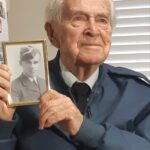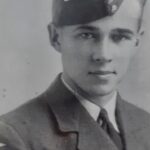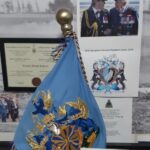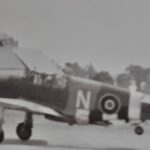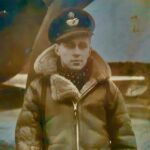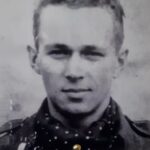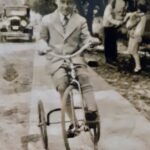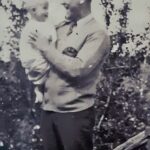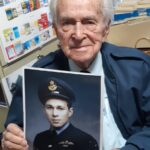Richard Rohmer was born January 24, 1924 in Hamilton, Ontario. His parents divorced when he was young, so Richard recalls growing up between the two households and dealing with the consequent difficulties. He attended several schools in southwestern Ontario and by his teen years – coinciding with the start of the war – he was working at Fleet Aircraft, a job that followed his lifelong love of airplanes. And quite naturally that led him into the RCAF when he turned 18. Richard joined up and found his place in the British Commonwealth Air Training Plan; he reported to Manning Depot in Toronto and soon went on to flying school, earning his pilot’s wings and heading overseas on a difficult trans-Atlantic run that saw his convoy come under U-boat attack. Once in Britain and having gone through OTU Richard was selected for a Reconnaissance unit, and trained on a P-51 Mustang. He would eventually fly 135 missions, and provide invaluable intelligence for the troops on the ground, especially once the Battle of Normandy was underway. On June 6, 1944 – D-Day – Richard left early in the morning and recalls seeing the Allied armada cross the channel, and he had a front row seat when the first Canadian troops landed on Juno Beach. He continued flying recon missions all during the summer, and on a fateful day in July 1944 he came upon a German officer’s car, which he reported. Soon tactical Spitfires came and shot the car up. Richard later learned that this was the staff car of General Erwin Rommel, the famed “Desert Fox” and commander of Hitler’s Atlantic Wall. His missions also included fire ranging missions, directing Allied artillery fire on targets such as bridges. By that time Richard’s squadron was stationed in the Netherlands, and he had reached his mission quota at 135, so he was returned to England, where he became an instructor, training the next generation of pilots to do what he had been doing. Richard remained in England for the duration of the war, and he recalls being in Bournemouth at the time of VE Day, returning to Canada shortly thereafter. He completed his education and went on to lead an illustrious life as he rejoined the rhythms of civilian life in postwar Canada. Gen. Richard Rohmer is an acclaimed author and lawyer and publisher, not to mention one of Canada’s most decorated heroes from the Second World War, counting among his many awards the Distinguished Flying Cross. He was interviewed by Scott Masters and Rishi Sharma at his home in Collingwood in May 2022.
Videos
Click next video below to keep watching
- 1. Introduction and Early Life
- 2. Training; Going Overseas
- 3. Arrival in England; London and the Mustang
- 4. The Cameras and the Crew
- 5. On the Lookout; Under Fire
- 6. Pre-June 6 Recon; The D-Day Briefing
- 7. D-Day; Based in France
- 8. The Falaise Gap; Rommel
- 9. The August 1 Sortie; Eindhoven
- 10. Gun Ranging; VE Day
- 11. Photographs and Memories; Concluding Thoughts

